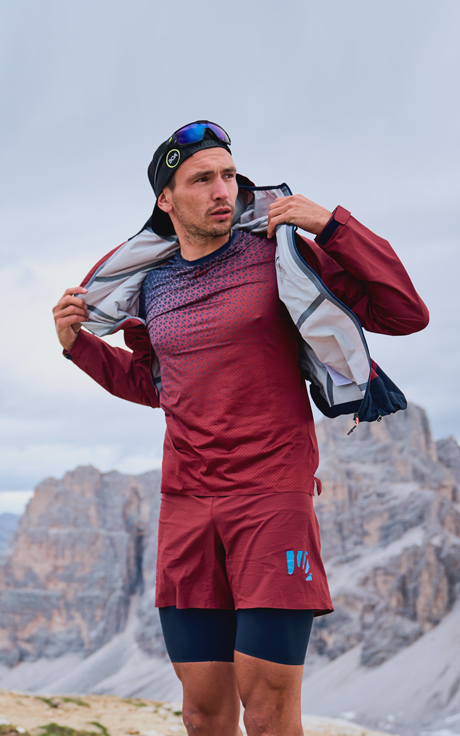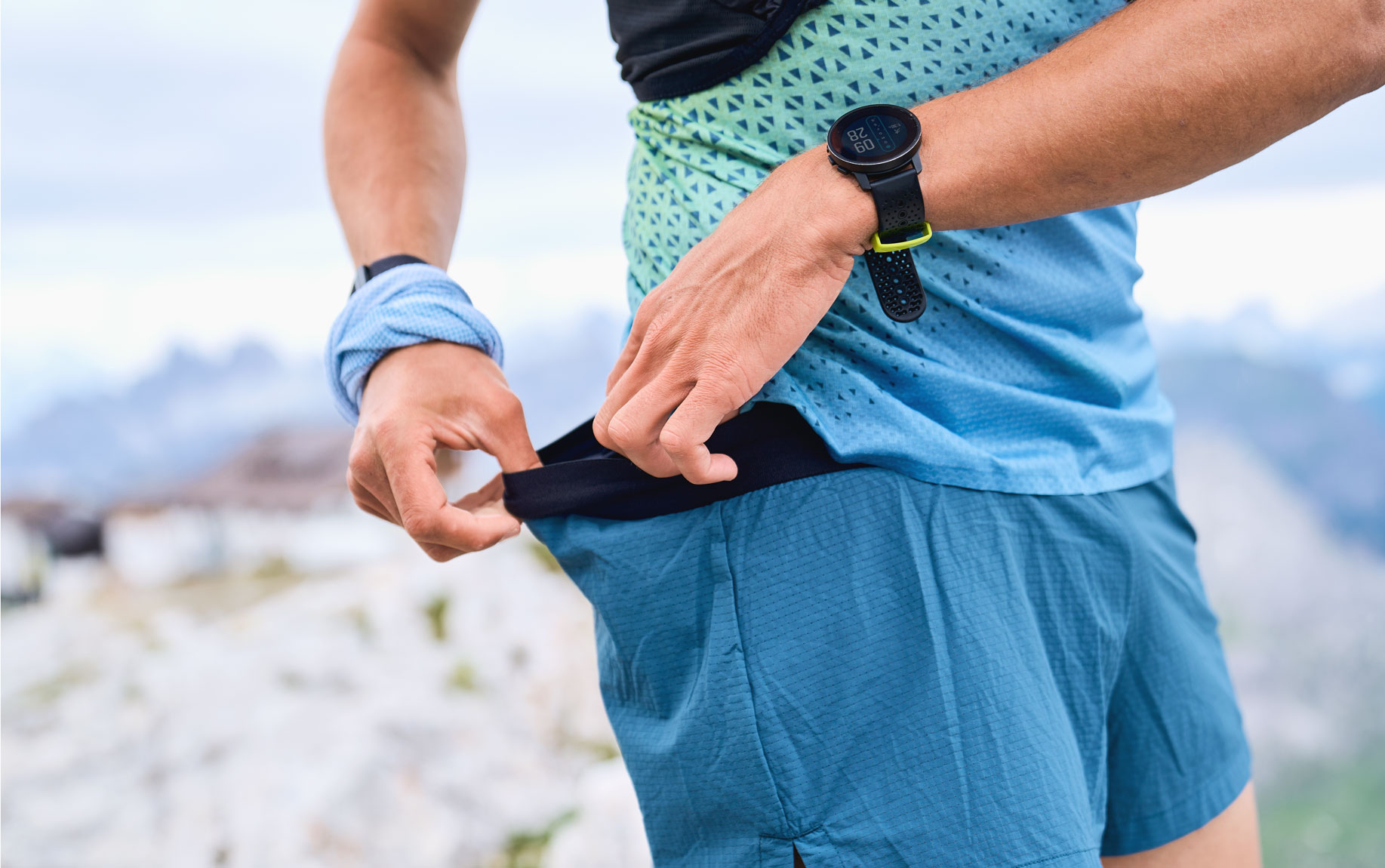
How to choose the right clothing for trail running?
Running is probably one of the most democratic sports there is. To start running, you don’t need any special equipment: a T-shirt, a pair of shorts, and a pair of shoes, and off you go — you’re ready to start. For trail running, though, especially for medium- and long-distance runs, you do need special shoes and clothing.
The basic rule? Functionality. Trail running clothing must be designed for the specific needs of the sport. It must offer protection from weather conditions such as rain and snow, but also from the wind, which can become a real issue at altitude. At the same time, it must be breathable to allow sweat to escape, especially when you’re tackling challenging climbs. Trail running clothing must be lightweight and comfortable. When you run you shouldn’t be thinking about anything other than the next meter of trail. You shouldn’t have to worry about annoying chafing on your thighs or back. The clothing is there, but you shouldn’t feel it. It should be seen, though. Trail running clothing must be visible, to allow runners to be identified both at night and in conditions of poor visibility.
Trail running products can be divided into the following categories:
Base layer
The base layer’s job is to wick moisture away from the skin to keep you dry and help your body regulate its temperature. Its importance becomes clear when you’re choosing clothing for trail running, a high-intensity activity that generates a lot of sweat — in both summer and winter.
The base layer is the layer in contact with the skin, which is why it must be as comfortable as possible, so as not to cause any type of problem. It must be close-fitting, and the seams, if present, should be flat, to prevent annoying rubbing, which over time can cause irritation and discomfort.
Today there are base layers on the market that are made with fabrics and technologies that inhibit the growth of bacteria and are therefore well suited for use over long distances.
Shorts

When you think of trail running clothing, shorts are certainly the item that tends to get the most attention. There are a thousand variations available: short or long, close-fitting or looser. What should you choose? Each type is designed to ensure a certain level of comfort based on the intensity, type of running, or season.
Close-fitting styles, whether short or long, are ideal for trail running, especially when you want to test yourself over long distances, as they prevent chafing and consequent irritation, even after many hours of use. Those who don’t want to sacrifice their style even when running can combine close-fitting inner shorts and loose, comfortable overshorts. Alternatively, for women, there are skirts with close-fitting built-in shorts underneath. And also shorts with integrated briefs that ensure breathability and minimal friction. For winter, the recommendation is to choose something long, close-fitting, stretchy, and warm, so you don’t immediately find yourself in difficulty with the first step; after five minutes your legs will have warmed up with the movement and you’ll immediately feel at ease.
Whatever your choice, the important thing is that you feel comfortable wearing the shorts and that they respect some simple rules. A good pair of trail running shorts must be breathable and functional. For this reason, many styles are full of pockets — easy to access even while you’re running — where you can stash energy bars, gels, or a soft flask, but also your car keys and cellphone.
T-shirt

When choosing trail running clothing, similar considerations apply to technical T-shirts as to shorts. Today there are high-performance T-shirts available that are designed to perform at their best in certain weather conditions.
The basic rule may be to wick away moisture, so you always stay dry, but on the hottest days you may instead want to choose a garment made of Polartec® Delta™, a special fabric that can retain some of the moisture, slowing the drying of the T-shirt and thus offering greater comfort, including during very intense activity.
A good T-shirt for trail running must always feel pleasant against the skin, it must not hinder movement, and, above all, any stitching, logos, printing, or graphics must not cause irritation during use.
Shell
A waterproof or windproof shell is a piece that you should always have with you when you head out in the mountains, including on a run. The weather in the mountains can change quickly, and even on the sunniest day you may find yourself dealing with a sudden downpour. This is why, when you’re choosing your trail running clothing, it’s important to take care in selecting a waterproof shell, which can save your run in the event of bad weather.
But it’s also important to protect yourself on the passes or summits where it’s windy, or simply when you stop for a break. For this reason, we recommend always carrying along a windproof jacket or vest that will keep you protected and prevent your body from cooling down too much.
In addition to protecting you from wind and water, a trail running shell must be breathable, lightweight, and compactible, so as to take up little space in your backpack.
But some models offer more, too. Today there are shells designed to satisfy the trail runner’s every need — jackets that are easy to put on, even over a backpack, and that have pockets allowing easy access to the water bottles on the shoulder straps of your backpack.
Accessories
When choosing trail running clothing, don’t forget the accessories — from a headband to prevent sweat from getting into your eyes, to a cap to protect you from the sun in the summer and the cold in the winter.
You’ll also want gloves for cold weather, and waterproof gloves to protect you from the elements. A neck warmer is always helpful in any season, for protecting your neck from the cold or your head from the sun’s rays.
Other accessories that can be useful for a trail runner include arm warmers and leg warmers, which provide a thermal layer that can help make sure you feel good and enjoy your run even when the temperature drops.
Conclusion

We’ve seen how to choose the best trail running clothing, from the base layer, whose job is to keep you dry by wicking moisture away from the skin, to the outer shell, which must be lightweight, waterproof, breathable, and compactible.
And let’s not forget the shorts, where the choice is seemingly infinite, with a multitude of models designed to meet different needs. It’s essential that the shorts be comfortable and that you can forget that you’re wearing them.
And, again, the technical T-shirt: breathable, lightweight, and quick drying — but not always. In fact, on the hottest days, it can be useful to have a garment that’s able to retain some moisture to cool you down.
Last but not least, the accessories, which are essential for enjoying trail running to the fullest.
There are a few fundamental rules behind the choice of the best trail running clothing: lightness, comfort, and performance.